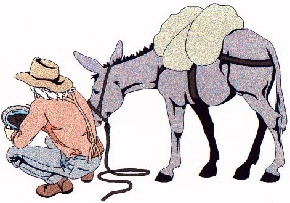 |
| Vol. 7, No. 11 | November 2002 | |
|
Lloyd G. Clements Community Center
7:00 PM (Board Meeting at 6:00 PM)
|
Selected from the "Colorado GOLD Prospecting" website
by Shawn Page
Colorado Mineral Belt
The 250 mile long Colorado Mineral Belt cuts diagonally across central and southwestern Colorado, in the heart of the Rocky Mountains. Mt. Elbert (14,431 feet) is the highest of many high peaks in the belt, all of which were glaciated during the Ice Age. The region has heavy snowfall in the winter, with mild, pleasant summers.
Placers can be found downstream from many of the mining districts in the Colorado Mineral Belt. The best known placers are those on North Clear Creek west of Denver, at Breckenridge, at Alma and Fairplay, and at Leadville, all of which have been extensively worked. The richest gravels were at Breckenridge, where some 800,000 ounces of placer gold were recovered between 1859 and 1972. Placers in the Leadville area yielded over 350,000 ounces, and North Clear Creek yielded over 300,000 ounces of gold. The Alma-Fairplay placers also yielded around 300,000 ounces of gold. The richest and most productive placer gravels are in the Front Range (northeast) portion of the Colorado Mineral Belt. The bucket-line dredge used at Fairplay was the largest in Colorado, and was in service until 1951.
The bucket-line dredge (also called bucket-ladder dredge) used at Fairplay was the South Platte Dredging Company's Dredge No. 1, called the "Fairplay Dredge." As the biggest bucket-line dredge in Colorado, it was even larger than Fairplay's "Snowstorm Dredge," Colorado's largest dragline dredge. The "Fairplay Dredge" was Colorado's last operating bucket-line dredge. It was moved to South America in the 1980s.
A move to save Fairplay's "Snowstorm Dredge" by the Park County Historical Society is being strongly supported by Colorado Springs' Gold Prospectors of Colorado. ~GPR Webmaster
Fairplay
The Fairplay district produced 202,000 ounces of placer gold, mostly along the South Platte River in the snowstorm and Fairplay Placers. Along Sacramento and Beaver Creek is excellent placer ground. The area Southeast of town in glacial out wash gravels contains placer gold. At the head of Fourmile Creek is the Horseshoe Mine and it was a good producer. North of Fourmile Creek and south of Mosquito Creek is the Sacramento Mine that produced a by product of gold.
Alma
The Alma district is located east of Leadville and had a total production of 1,320,00 ounces of lode gold and 28,000 ounces of placer gold between 1859-1959. Northeast of Alma about a 1/2 mile, along the east side of the South Platte River, the placers produced great. Coarse gold nuggets to several ounces have been found. All the area tributary creeks and gulches, in gravel deposits contain placer gold. On Mount Lincoln and Mount Bross, rich area lode mines, especially the London Mine (richest producer in the county, closed in 1942) produced most of the gold and silver. Near the head waters of the South Platte River, along the Continental Divide, on North Star Mountain, all area gulches contain placer gold. Northwest of Alma, 2~6 miles, many small mines produced lode gold. North of Alma 5~10 miles is the Consolidated Montgomery Mine. This mine is at an altitude of around 11,000 feet and produced a by product of gold. In Buckskin Gulch, the Sweethome Mine was a good producer. Around Mosquito creek, all streams produce placer gold.
Breckenridge
In the Breckenridge or Blue River district, including the tipper valley of the Blue River between the Front Range on the East and the Tenmile Range on the West had a total production of 1,000,000 gold ounces of which 735,000 ounces came from placer deposits. In all regional stream channels, gulches, benches, etc. you can find placers. East and northeast of town, in area of about 5 square miles, there are many lead-silver mines that produced a by-product gold. In Georgia Gulch, on North side of Farncomb Hill, rich area placers discovered in 1859, area lode mines, discovered in 1880, especially the Wellington Mine, chief producer, it was so rich in native gold that pockets supplied collectors and museums throughout the world with specimens of wire and leaf gold. Along the Swan and Blue rivers, many deep placers worked by dredges after 1900.
Frisco
Frisco is located 4 miles southwest of Dillon and in the Tenmile district. It includes old camps of Kokomo and Robinson in the Tenmile Valley on the West Side of the Tenmile Range and had a total production from 1861-1959, of 52,000 gold ounces, mostly as by-product of base-metal ores. Area old mine dumps contains gold, with galena and pyrite. Various local small creek placers are around like Kokomo, in McNulty Gulch, rich placers discovered in 1861, and many mines along valley of Tenmile creek for 2-3 miles northeast and 5 miles southwest to Robinson. On East Side of valley, in the Tenmile Range, on West, slopes, many base-metal mines produced lode gold.
Boulder
Northwest of Boulder 3-8 miles is the Gold Hill Sugarloaf district. This district is about 12 square miles and had a total production of 412,000 ounces 1859-1959. In the area creek beds, terraces, benches, etc. you can find placer gold over 3,000 ounces have been produced. Gold Hill Mine, largest producer, including several adjoining mines produced lode gold and silver. The old camps of Sugarloaf, Rowena, Salina, and Sunshine are great places to explore. There are many area mines that produced lode gold and silver. Southwest of Boulder 4 miles to Magnolia, reached by steep grades, numerous high-grade mines that produced lode gold in tellurides. The total production of 130,000 ounces was recorded. West of Boulder 17 miles and 4 miles Northwest of Nederland, is the Grand Island-Caribou district in southwest part of county. The Grand Island- Caribou district had a total production between 1932-59, of 10,006 ounces. There are numerous area lead-silver mines that produced a by-product of gold. The Cardinal and Eldora mines are in the area and produced lode gold.
Jamestown
Jamestown is in the Central district. Nine miles northwest of Boulder there were many area mines. Lefthand Creek, north of Gold Hill, Bummers Gulch, Coon Trail, North Beaver and South Boulder Creeks, southeast of Caribou contain placer gold. James Creek above Jamestown contains placer gold. Central Gulch, west of Jamestown contains placer gold. Upper Fourmile Creek, northwest of Sugarloaf contains placer gold. It had a total production of 207,000 gold ounces. There are many area mines that produced gold in pyrite and telluride minerals. The Jamestown, Gold Hill and Ward area mines all produced lode gold.
Georgetown / Silver Plume
Georgetown / Silver Plume is on U.S. 6 and 40-42 miles west of Denver. The steep grades in this area are treacherous. Georgetown / Silver Plume is in west part of county. This district consisted of 25 square miles and had a total production of around 145,000 gold ounces. Area mines produced a by-product of gold. Southwest of Georgetown / Silver Plume 6 miles is the Argentine or west Argentine district. Just east of the Continental Divide, this district had a total production of 25,400 gold ounces. Along Leavenworth Creek, and on the southeast side of Leavenworth Mountain on the southeast slopes of McClellan Mountain, at head of Leavenworth Creek, 6 mi. farther southwest, many area mines produced lode and by-product gold. On Kelso Mountain, area mines produced lode gold. The Belmont Silver Lode and the Baker Mine were the largest district producers of lode gold.
Idaho Springs
Idaho Springs district embraces an unbroken succession of gold deposits extending from the town to Central City and Blackhawk in Gilpin County. It had a total production in this district of about 1,805,000 gold ounces. The mines at Cascade, Coral, Jackson Bar, Paynes Bar, Spanish Bar, and Virginia Canyon all produced lode gold. In Chicago Creek, Nevada and Illinois gulches, and Missouri Flats, there were extensive placers operations. The Gregory, Russell, Bates, Bobtail, and Mammoth mines all produced lode gold. Northwest of Idaho Springs, 2.5 miles, at Trail, Freeland and Lamartine there were numerous mines. Along Trail Creek and the Lamartine Mine, 2 miles southwest on the divide between Trail Creek, and Ute Creek, 2 to 4 miles off U.S. 6 and U.S. 40. There are many lode gold mines. West of Idaho Springs 6 miles, along Silver Creek, placer workings from old can still be observed. Northwest of Idaho Springs 10 miles (2 miles on U.S. 40 and 8 miles on Route 285), to Alice (Lincoln, Yankee Hill, elevation 10,000-11,000 feet), numerous area mines produced lode gold. The camps of Montana (Lawson, Dumont, and Downieville), the west extension of district on U.S. 6 and U.S. 40, many area mines produced lode gold.
Ê
Arkansas River
The entire Arkansas River Valley in southern Lake County has had productive placer locations with some of the better locations being Box and Lake Creeks and California Gulch. Most of the tributaries can be counted on to turn in small amounts of placer gold.
Reported By: Greg Ferris
The confluence of the Arkansas River and Lake Creek area was the general site of some the most extensive and successful placer mining operations in Colorado. Within a short distance are placer areas from numerous sources.
Some 4 miles upstream from Lake Creek the Arkansas River is joined by Box Creek and several smaller outlets which provided source gold from the eastern slopes of Mount Elbert (Colorado's tallest mountain). This area was extensively worked for a considerable time period and is generally known as the Derry Ranch Placers. Lake Creek was a principal contributor of placer gold now found in the Arkansas River, draining water courses from the southern and southeastern slopes of Mount. Elbert and adjoining peaks. The majority of the gold originally was accumulated in moraine deposits, a short (6 mile) drive west on Hwy. 82 into the Twin Lakes area will quickly demonstrate the glacial valley. These lakes are now used for the production of hydroelectric power and the saving of fresh water. Originally the lakes (actually 1 lake) were created by two separate glacial flows with the end moraines providing the base dam and the upper/lower lake division. Needless to say, with man's "damn" interference, gold no longer is sorted and fed down into Lake Creek from the glacial gravels.
Just below the dam for a distance of about 3 miles Lake Creek again flows unimpeded. Dennis O'neil of Balltown, Colo. (a little collection of locals at the junction of Lake Creek and the Arkansas River) owns numerous claims on both Lake Creek and the Arkansas River which are open to daily fee users. Each of the various available claims areas is restricted to different prospecting methods. The most common activities are high-banking and panning. Dredging is allowed, by permit from BLM, on the Arkansas River. I have found that there are some virgin gravels on the Eastside of Lake Creek in the designated high-banking area but it is tough work as these are packed gravels. It should be noted that of the gold that is found, like most Colorado placer gold, it is of the "fine" variety and your prospecting technique requires care to maximize efforts. Occasionally small pickers and some minor flakes are found. Black sands are abundant and are filled with microscopic particles of gold. In this area water must be pumped almost 200' and considerably uphill. Fortunately you can drive to within 25-50' of the work area. Other areas are designated "panning only" along Lake Creek banks.
On the Arkansas River, just 100-200 yards downstream from Lake Creek are some good high-banking areas. These most of these gravels are actually tailings piles from hydralicking and fluming operations of the late 1800's. The old miners must have only been interested in the big pieces because there are considerable fines and flakes to be found. Access is also easy by parking by State Hwy. 24 and crossing over railroad tracks to work area. Water access is also easier here although attention must be paid to fluctuating water levels as the hydroelectric operations on Twin Lakes can allow or stop large volumes of water in very short periods.
I have discovered no real secret tips for working the tailings area, just make sure you aren't reworking the tailings of a "modern" prospector. The previously mentioned high-banker area on Lake Creek however does have distinct layers to be worked and better finds can be had for the gambler. As with most of the upper Arkansas River drainage no matter where you work you will find some success as I have never been able to run a single pan between the Pan Ark Lodge (Derry Ranch Placers) all the way down to Salida (50+ miles) without at least finding some color.
Source for this information: Selected areas from a much more extensive article found at Shawn Page's website:
http://www.geocities.com/gold_prospecting/ColoradoGold_Prospecting.html.About the author: Shawn Page has been prospecting on and off in Colorado since around 1986. He saw his first gold in its native setting when his father and late grandfather introduced him to his "first flake" in Clear Creek County near Central City. It was then he discovered "Gold Fever!" Since then, he has traveled and enjoyed much of Colorado's great outdoor activities with his wife Kyla, son Tanner, and daughter Hollynn.
by Rick Miska
Hi all! Things have really wound down for the year. Not a whole lot of prospecting type of stuff going on this month. I think the main form of gold this month was the moisture we got with the snowstorms.
I have some bad news this month. Member Jill Eads' car was stolen very recently and has yet to be recovered. The club lost some shirts, hats, a gold display case, and other odds and ends. To me, that stuff is all replaceable, so I am not upset. I am more bummed for Jill and the loss of her car. Watch for people wearing club hags and shirts that don't look familiar, and ask them where they got it. Who knows, maybe it will lead to getting her car and our stuff back.
See ya at the meeting,
Rick
by Gary Hawley
Greetings to all "gold Prospectors of the Rockies"
I missed my chance to go south for the winter, Daylight Savings Time switched and I find myself going to and coming from work in the dark, the Highway Department sporayed stuff on the road that sticks to my truck, and the Water Board made a rule that I can't wash my truck at home. However, I can help lessen this drought by paying $5 to use a carwash. I wonder where that water comes from?
On a better note, I did find time to go prospecting twice since our last meeting. it's very therapeutic to meet with some friends and spend a couple of hours digging for gold. And, of course, finding gold makes it all the more fun. I forgot about going south and0 whatever time of day it was, was okay with me. I figure the Highway Department just wanted to help me keep my truck from freezing up and I would have missed my prospecting trips, if I had taken that time to wash my truck.
Our general meetings continue to promote the friendship and fun of gold prospecting. We share important prospecting information, have great speakers, and have good food to share during the break. We continue to have one fo the most progressive clubs in Colorado because our members really care about gold prospecting and are willing to get involved to keep this hobby alive.
We will have Board Member elections at the November meeting. Several people have already accepted nominatinos and their names will be presented for voting. There are more positions available, so please step up and make yourself available to help your club.
Until next time, may the nuggets you find be worth the effort you put into finding them.
by Gary Hawley
The Octoberr question brought about some interesting results. The question was: What was the name of the largest Colorado Dredge built in 1940-1941 near Fairplay and what was the capacity of this dredge?
My source, Gold Panning and Placering in Colorado, by Ben H. Parker, Jr., states this dredge was called the South Platte No. 1 with a capacity of 15,000 cubic yards per day.
The interesting point is, several members guessed the Snow Storm Dredge and had books that indicated a similar capacity. Apparently, the build dates of both dredges are fairly close. The major difference that I am aware of is that the South Platte No. 1 was a moveable flotation dredge while the Snow Storm Dredge was a stationary dredge. So, in fairness, I accepted both names as correct.
Now let's see what answers are presented for th November question: In 1849 or 1850, two Georgians, John Beck and Louis Ralston, while on their way to California, found gold on two streams in Colorado. What were the names of the streams? Name either stream for one drawing ticket or both streams for two tickets.
by Doug Taylor
We had another good turnout for October's Find of the Month, with Jerry Jensen taking the votes for his carbide lamp that he found in Idaho Springs. he used a metal detector to locate his find. Jerry also brought in three small vials of gold that he removed from Clear Creek with a high banker.
Larry Boyes brought in an 1891 Indian head cent and a silver ring with a stone in it. Larry found his treasure in City Park with a Mine Lab detector.
Racheal Boyes had a silver ring to display that she found in City Park. She was using a metal detector.
Thaks to all the club members who participate in the Find of the Month/Year program. It is always good to see the treasure that is being uncovered and put on display.
|
|
|
| Wednesday, October 24, 2002 | |
| 0.6 gram nugget - | Donovan Greene |
| 0.7 gram nugget - | Kim Beggs |
| 0.8 gram nugget - | Nora Dorn |
| 1.7 gram nugget - | Jeff Mosteller |
| 0.6 gram nugget - | Donna Mosteller |
| 0.8 gram nugget - | Carl Sauerland |
| 0.7 gram nugget - | Fritz Meyer |
| 0.8 gram nugget - | Ken Oyler |
| 0.6 gram nugget - | Hank Innerfeld |
| 0.8 gram nugget - | Ken Barker |
| 0.8 gram nugget - | Kim Beggs |
| 0.8 gram nugget - | Sue Clover |
|
|
|
| 0.7 gram nugget - | Don Dixon Donated by Randy Solomon |
| GPR Club Shirt - | Linda Shubert Donated by the Club |
|
|
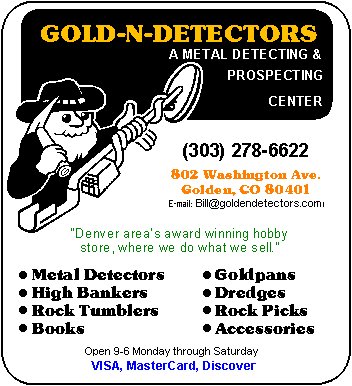
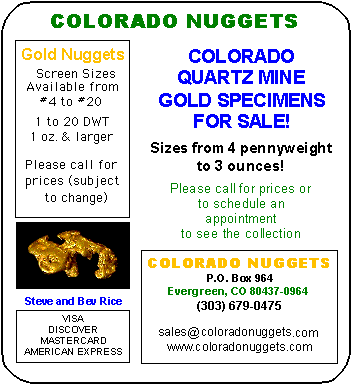

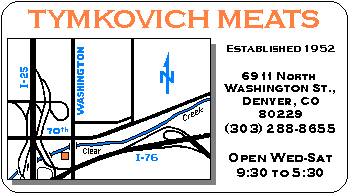
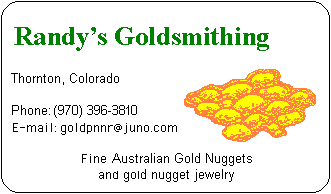

|
is an official publication of the Gold Prospectors of the Rockies, a Denver-based, Colorado nonprofit organization established in 1995 for the enjoyment of gold prospecting and metal detecting. Club meetings are held on the third Wednesday of each month, 7:00 PM, at the Lloyd G. Clements Community Center, 1580 Yarrow Street, Lakewood, Colorado (1 block west of Wadsworth, 1 block north of Colfax). Individual or family membership fees are $30.00 for the first year, $25.00 for each subsequent year. Non-commercial business-card-sized classified text ads for members are free of charge. Commercial display ads must be detecting, prospecting, or treasure related and are available to anyone at a modest charge: 1/8 page (approximately 2"h x 3.5"w business card size) - $6.00 per month. 1/4 page (approximately 4"h x 3.5"w) - $12.00 per month. 1/2 page (approximately 4"h x 7"w or 8.5"h x 3.5"w) - $24.00 per month. Full page (approximately 8.5"h x 7"w) - $48.00 per month. The Gold Nugget is open to and gladly accepts submission of information and articles. All article submissions must be received by the editor no later than the first Wednesday of the month for inclusion in the next month's issue. The GPR must receive any required payments for commercial ads prior to their inclusion. Include publication information on articles clipped from other publications. The Editor reserves the right to edit all submissions. Bulletin editors may print any article from this newsletter with credit given to the newsletter and the author. Contact: The Gold Nugget Editor, The Gold Prospectors of the Rockies, PO Box 621988, Littleton, CO 80162-1988. E-mail: The Gold Nugget Editor. |